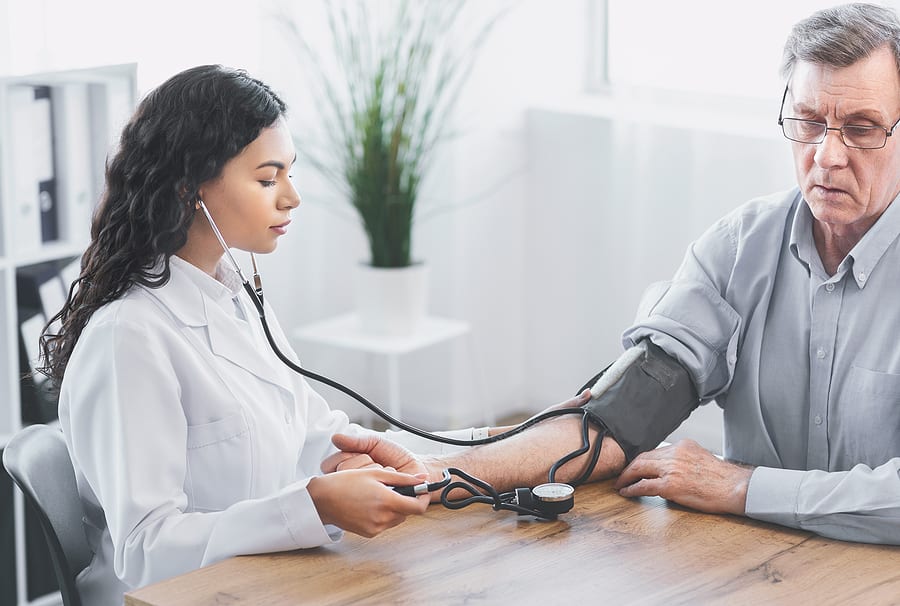Stroke is the 5th leading cause of death in the US, killing about 130,000 Americans a year. Risk of one occuring increases as you age. For the safety of your elderly loved one, it is important to know the signs of a stroke, so that you can better help protect your loved one.
What is a Stroke?
A stroke is a sudden interruption of blood flow to the brain. Most strokes are caused by a blockage in the arteries going from the heart to the brain, but there are other potential causes, depending on the type of stroke. They often happen rapidly, and medical help is required as soon as possible. Acting quickly in the event of a stroke can make a big difference. On average, those who receive emergency care within 3 hours of having one will have a better overall outcome than those who don’t.
Signs of A Stroke: FAST
One of the most accepted methods of identification for a stroke is known as FAST; which stands for Face drooping, Arm weakness, Speech, Time to call. FAST is used by the National Stroke Association and the American Heart Association.
Face Drooping
During and after a stroke, you may notice drooping of their face. Part of their face may feel numb. Ask the person to smile. Someone suffering from a stroke may not be able to smile on one side of their face.
Arm Weakness
One arm (the same side as the facial droop) may weaken or become numb. Ask the person to raise their arms. The arm on the affected side may drift downward, or may not move as well.
Speech
Speech may become slurred and difficult to understand. Ask the individual to repeat a simple phrase. Garbled or slurred speech when repeating the phrase should be a red flag.
Time to Call
Call 911 immediately. Even if the signs fade over time, it is best to call for emergency services. If possible, note the time that you notice the symptoms starting, so that the first responders and doctors are aware of when it occurred.
Types of Stroke
There are three types of strokes. While the main signs and symptoms remain the same, the severity of the stroke can differ. Medical attention is needed regardless of the type. A medical professional will best be able to identify which has occurred, and can act accordingly in their treatment.
Ischemic Stroke
This is the most common kind of strokes. Roughly 80% of all strokes are Ischemic Strokes. This type is caused when a clot or other blockage prevents blood flow through an artery to the brain. This blockage can cause brain cells to die as they are left without oxygen. Bad cholesterol is a common cause of Ischemic Strokes, as cholesterol deposition can narrow the arteries.
Transient Ischemic Attacks
While a Transient Ischemic Attack (TIA) is a type of Ischemic Stroke, there is a difference. A TIA occurs when a temporary block in the arteries causes a stroke. This is generally a warning sign that the artery is not clear. A bigger, more deadly Ischemic Stroke may occur if improvements are not made to reduce risks.
Intracerebral Hemorrhage
An Intracerebral Hemorrhage means that an artery within the brain has ruptured. This causes blood to compress the structures of the brain as it is released. As blood leaks inside the brain, the pressure will continue to build. This can lead to unconsciousness or even death. High Blood Pressure (Hypertension) is the most common cause of this.
Subarachnoid Hemorrhage
This type of hemorrhagic stroke occurs when an artery ruptures in the space around the brain. This can cause immediate and intense headaches, nausea, and vomiting. This type is most often caused by abnormalities of the arteries at the base of the brain, known as a cerebral aneurysm. The cause of cerebral aneurysms is unknown but can occur at any age.
Additional Stroke Symptoms
There are many other common stroke symptoms, but they are often not as evident as those in the FAST model. Dizziness, and overall loss of balance or coordination, can occur. Numbness, especially on one side of the body, is one of the first signs the victim may notice themselves. Blurred vision and trouble seeing can also be a sign of stroke, especially in one eye.
As strokes occur in the brain, headaches are a common symptom that stroke victims suffer from. Many victims report that these sudden, severe headaches are the worst that they have ever felt.
Safe Harbor Healthcare Services does not provide medical or healthcare advice via articles. This material has been prepared for informational purposes only, and is not intended to provide, and should not be relied on for medical advice.
Safe Harbor Healthcare Services has been providing excellent home care on Staten Island since 1967. Our services help the elderly and disabled live safely and independently; while giving their families the peace of mind they need. For more information, contact Safe Harbor by clicking here, or call us at (718)-979-6900.
For more information on identifying stroke symptoms, visit the American Stroke Association.

